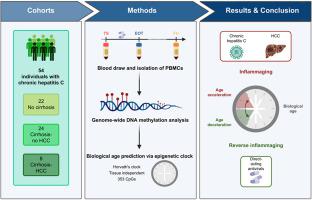Journal of Hepatology ( IF 26.8 ) Pub Date : 2022-09-21 , DOI: 10.1016/j.jhep.2022.08.042 Carlos Oltmanns 1 , Zhaoli Liu 2 , Jasmin Mischke 1 , Jan Tauwaldt 1 , Yonatan Ayalew Mekonnen 3 , Melanie Urbanek-Quaing 1 , Jennifer Debarry 4 , Benjamin Maasoumy 5 , Heiner Wedemeyer 5 , Anke R M Kraft 1 , Cheng-Jian Xu 6 , Markus Cornberg 1

|
Background & Aims
Chronic hepatitis C virus (HCV) infection can be cured with direct-acting antivirals (DAAs). However, not all sequelae of chronic hepatitis C appear to be completely reversible after sustained virologic response (SVR). Recently, chronic viral infections have been shown to be associated with biological age acceleration defined by the epigenetic clock. The aim of this study was to investigate whether chronic HCV infection is associated with epigenetic changes and biological age acceleration and whether this is reversible after SVR.
Methods
We included 54 well-characterized individuals with chronic hepatitis C who achieved SVR after DAA therapy at three time points: DAA treatment initiation, end of treatment, and long-term follow-up (median 96 weeks after end of treatment). Genome-wide DNA methylation status was determined in peripheral blood mononuclear cells (PBMCs) and used to calculate epigenetic age acceleration (EAA) using Horvath’s clock.
Results
Individuals with HCV had an overall significant EAA of 3.12 years at baseline compared with -2.61 years in the age- and sex-matched reference group (p <0.00003). HCV elimination resulted in a significant long-term increase in DNA methylation dominated by hypermethylated CpGs in all patient groups. Accordingly, EAA decreased to 1.37 years at long-term follow-up. The decrease in EAA was significant only between the end of treatment and follow-up (p = 0.01). Interestingly, eight individuals who developed hepatocellular carcinoma after SVR had the highest EAA and showed no evidence of reversal after SVR.
Conclusions
Our data contribute to the understanding of the biological impact of HCV elimination after DAA therapy and demonstrate that HCV elimination can lead to “reverse inflammaging”. In addition, our data support the potential use of biological age as a biomarker for HCV sequelae after SVR.
Impact and implications
Chronic hepatitis C virus infection is now curable with direct-acting antivirals, but it remains unclear whether hepatitis C sequelae are fully reversible after viral elimination. Our results suggest that epigenetic changes or acceleration of biological age are reversible in principle, but this requires time, while a lack of reversibility appears to be associated with the development of hepatocellular carcinoma. While most clinical risk scores now take chronological age into account, it may be worthwhile to explore how biological age might improve these scores in the future. Biological age may be a cornerstone for the individualized clinical assessment of patients in the future, as it better reflects patients' lifestyle and environmental exposures over decades.
中文翻译:

逆转炎症:HCV 治愈对生物学年龄的长期影响
背景与目标
慢性丙型肝炎病毒 (HCV) 感染可以通过直接作用抗病毒药物 (DAA) 治愈。然而,并非慢性丙型肝炎的所有后遗症在持续病毒学应答 (SVR) 后似乎都是完全可逆的。最近,慢性病毒感染已被证明与表观遗传时钟定义的生物年龄加速有关。本研究的目的是调查慢性 HCV 感染是否与表观遗传变化和生物年龄加速相关,以及这在 SVR 后是否可逆。
方法
我们纳入了 54 名特征明确的慢性丙型肝炎患者,他们在 DAA 治疗后的三个时间点达到了 SVR:DAA 治疗开始、治疗结束和长期随访(治疗结束后的中位时间为 96 周)。全基因组 DNA 甲基化状态在外周血单核细胞 (PBMC) 中确定,并用于使用 Horvath 时钟计算表观遗传年龄加速 (EAA)。
结果
与年龄和性别匹配的参考组中的 -2.61 岁相比,HCV 感染者在基线时的整体显着 EAA 为 3.12 岁 ( p <0.00003)。HCV 消除导致所有患者组中由高甲基化 CpG 主导的 DNA 甲基化显着长期增加。因此,EAA 在长期随访中减少到 1.37 年。EAA 的减少仅在治疗结束和随访之间显着 ( p = 0.01)。有趣的是,8 个在 SVR 后发展为肝细胞癌的个体具有最高的 EAA,并且在 SVR 后没有显示逆转的证据。
结论
我们的数据有助于理解 DAA 治疗后 HCV 消除的生物学影响,并证明 HCV 消除可导致“逆转炎症”。此外,我们的数据支持生物年龄作为 SVR 后 HCV 后遗症生物标志物的潜在用途。
影响和启示
慢性丙型肝炎病毒感染现在可以用直接作用的抗病毒药物治愈,但尚不清楚丙型肝炎后遗症在病毒消除后是否完全可逆。我们的结果表明,表观遗传变化或生物年龄的加速原则上是可逆的,但这需要时间,而缺乏可逆性似乎与肝细胞癌的发展有关。虽然现在大多数临床风险评分都考虑了实足年龄,但探索生物学年龄在未来如何改善这些评分可能是值得的。生理年龄可能是未来患者个体化临床评估的基石,因为它更好地反映了患者几十年来的生活方式和环境暴露。











































 京公网安备 11010802027423号
京公网安备 11010802027423号